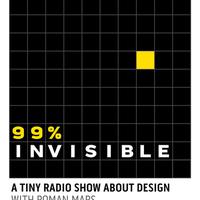99% Invisible-09- 99% Private
Roman Mars (RM): This is 99% Invisible.
Stephanie Foo (SF): That's Roman Mars. Rm: And that's Stephanie Foo. SF: The plaza and seating area of this building are provided and maintained for the enjyoment of the public, from 8am to 6pm. Privately owned public open space.
RM: POPOS
SF: P-O-P-O-S
Blaine Merker (BM): And it has this logo that says “public open space” with kind of this little tree shaped like a house. And all of them have the same logo. The city requires that logo to be on there.
SF:It's a cool logo. BM :Yeah. Pretty small sign though.
BM: My name is Blaine Merker. I'm an artist and part of a group of artists and designers called Rebar. We're based in San Francisco. BM: POPOs- they're kind of a unique set of spaces that were required to be provided by the developer as a condition of approval for the developer's building. RM: So the POPOS are on private property. They're owned, most likely, by the owner of the building. BM: They look like public space. They feel like public space, for the most part. This one that we're standing in has granite walkways and fountains and grass. RM: But technically speaking, these are totally privately owned.
BM: The only catch is that the developer is legally obliged to make this open to the public and to allow anyone to use it.
RM: And no one's quite sure what's allowed here, who's in charge, and what the codes of behavior should be. And just because they're public doesn't mean they're easy to find. BM: So this is sort of a strange environment to walk through to get to a public space.
SF: Yeah, it's got nice art though! BM: Yeah.
SF: 536 Mission
BM: It feels like walking into a library.
BM: You'll see when we walk through security, there'll be this moment where you're like ‘okay, I just crossed the threshold.' Making eye contact with people in authority and sort of acknowledging them– that's not something I ever feel in a park, you know? You don't walk into Dolores Park and have to nod to someone like “yes, it's okay that I'm here.” BM: There's cameras. One, two three cameras in here. You wanna try some badmitton?
SF: In here?
BM: Why not?
SF: Yeah, let's do it! BM: There's a whole set of invisible codes and regulations that shape our behavoir. Most of us aren't really consciously aware of them. How you hold yourself in public, where you think you can sit down, who you can talk to. It's only by doing something to push back against those codes that you actually can see the codes. Sort of like a scientist firing an electron at an atom to see where it is. If you fire an electron at an atom, you actually change the course of the atom. You're in one of these spaces. When you actually push back against the codes of behavoir, you actually change the codes of behavior while you do that.
SF: And nothing happened!
BM: Nothing happened!
SF: Everyone was just like “alright.”
BM: We definitely played long enough to get noticed on camera, right?
SF: Right? And nobody came.
BM: Nobody came. Score one for public space.
RM: But if you really want to test the tolerance of a privately owned public open space, badmitton may not be the best test. If you really want to make someone in authority uncomfortable, the most subversive act, especially right now, may be doing nothing at all.
BM: There's a few behaviors that you can sort of possibly do that allow you to be idle, like fiddling with your thumbs or smoking, or reading a book. But to just, like lie down and do nothing, not okay. It draws attention to do nothing.
RM: The San Francisco Planning and Urban Research association, which has been better known as SPUR, has a great guid to all the POPOS in the city and reccommendations about how to improve current and future POPOS. Including a proposal to codify some of these rules for the social aspects of privately owned public open spaces. I think it's key to keep in mind that POPOS will never fully supplant the need for a true commons, for true public spaces in a city. POPOS can be these great hidden gems in the nooks and crannies of a city, but even if you're allowed to play badmitton, the fact that you have to test for it means these spaces aren't really ours. SF: This episode of 99% Invisible was produced by Roman Mars and Stephanie Foo, with support from Lunar. It's a project of KALW, The American Institute of Architects San Francisco, and the Center for Architecture and Design. RM: To find out more, or maybe tell the world about your favorite little private corner of the city, go to 99percentinvisible.org

